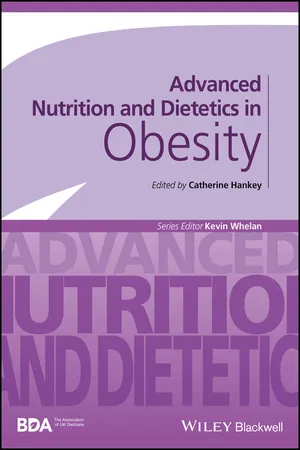
- English
- ePUB (mobile friendly)
- Available on iOS & Android
Advanced Nutrition and Dietetics in Obesity
About this book
This addition to the British Dietetic Association Advanced Nutrition and Dietetics book series is written for clinicians and researchers who work with any aspect of obesity and its comorbid conditions. Featuring contributions from leading researchers and practitioners from around the globe Advanced Nutrition and Dietetics in Obesity offers a uniquely international perspective on what has become a worldwide public health crisis.
Chapters cover a full range of new ideas and research on the underlying drivers of obesity in populations including discussions on the genetic and clinical aspects of obesity, along with expert recommendations on how to effectively manage and prevent this chronic and persistent disease.
Providing a comprehensive overview of the key literature in this field, Advanced Nutrition and Dietetics in Obesity is an invaluable resource for all those whose work should or does embrace any aspect of obesity.
Frequently asked questions
- Essential is ideal for learners and professionals who enjoy exploring a wide range of subjects. Access the Essential Library with 800,000+ trusted titles and best-sellers across business, personal growth, and the humanities. Includes unlimited reading time and Standard Read Aloud voice.
- Complete: Perfect for advanced learners and researchers needing full, unrestricted access. Unlock 1.4M+ books across hundreds of subjects, including academic and specialized titles. The Complete Plan also includes advanced features like Premium Read Aloud and Research Assistant.
Please note we cannot support devices running on iOS 13 and Android 7 or earlier. Learn more about using the app.
Information
SECTION 1
Introduction
Chapter 1.1
Definition, prevalence and historical perspectives of obesity in adults
1.1.1 Definitions of overweight and obesity
| BMI* | WHO classification | Popular description |
| <18.5 | Underweight | ‘Thin’ |
| 18.5–24.9 | Healthy weight | ‘Healthy’ |
| 25.0–29.9 | Overweight | ‘Overweight’ |
| 30.0–34.9 | Obesity I | ‘Obese’ |
| 35.0–39.9 | Obesity II | ‘Obese’ |
| 40 or greater | Obesity III | ‘Morbidly or seriously obese’ |
| Characteristic of obesity measured | Methods |
| Body composition | BMI Underwater weighing Dual‐energy X‐ray absorptiometry (DEXA) Isotope dilution Bioelectrical impedance Skinfold thickness |
| Regional distribution of fat | Waist circumference; waist‐to‐hip ratio Computerised axial tomography Ultrasound Magnetic resonance imaging (MRI) |
| Energy intake | Dietary recall or record ‘macronutrient composition’ by prospective dietary record or dietary questionnaire |
| Energy expenditure | Doubly labelled water Indirect calorimetry (resting) Physical activity level (PAL) by questionnaire Motion detector Heart rate monitor |
Why use BMI?
Interpretation of BMI: defining a ‘healthy weight’ for a particular society
| Metabolic syndrome | 30% of middle‐aged people in developed countries have features of metabolic syndrome |
| Type 2 diabetes | 90% of people with type 2 diabetes have BMI >23 kg/m2 |
| Hypertension | 5x risk in obesity 66% hypertension linked to excess weight 85% hypertension associated with BMI >25 kg/m2 |
| Coronary artery disease (CAD) and stroke | 3.6x increase in risk of CAD for each unit change in BMI Dyslipidaemia progressively develops as BMI increases from 21 kg/m2 with rise in small‐par... |
Table of contents
- Cover
- Title Page
- Table of Contents
- Preface
- Foreword
- Editor biographies
- Contributors
- Abbreviations
- SECTION 1: Introduction
- SECTION 2: Consequences and comorbidities associated with obesity
- SECTION 3: Aetiology of obesity in adults
- SECTION 4: Weight management in adults
- SECTION 5: Aetiology of obesity in children
- SECTION 6: Weight management in children
- SECTION 7: Public health and the prevention of obesity
- Index
- End User License Agreement